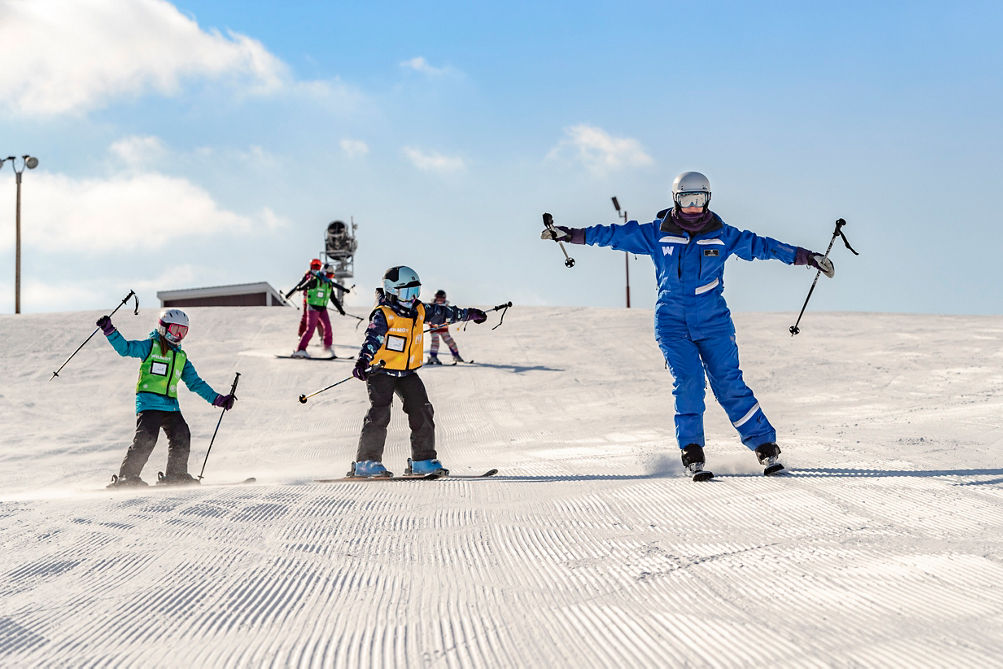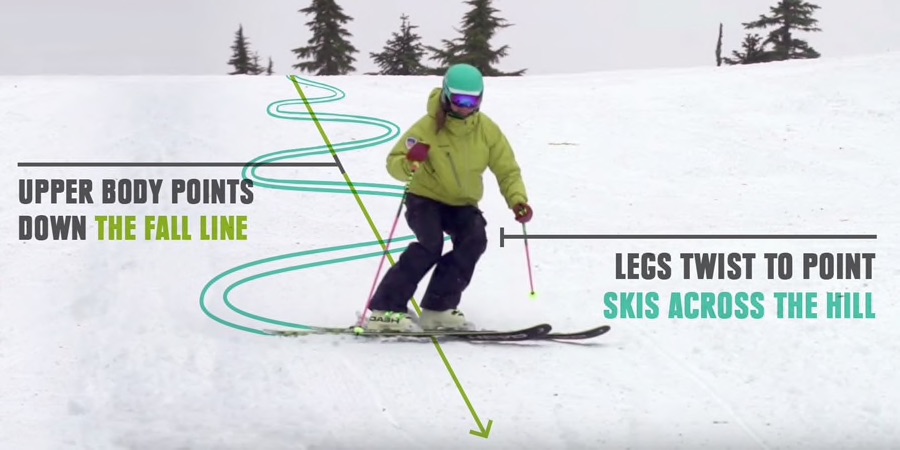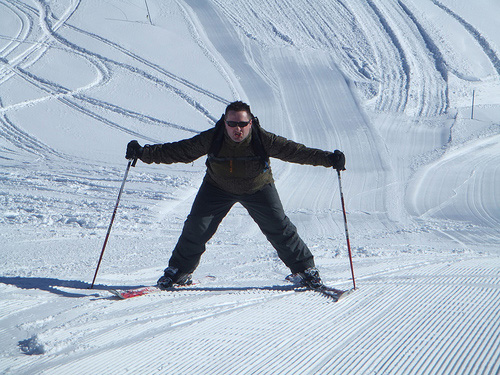
You are out skiing at your favorite resort, and while enjoying a ride up the chairlift, you look down. You see a first-time teen slowly making their way down the hill. There is a child ripping turns and jumping off everything in sight, and a middle-aged man with an instructor working on turn shape. Many styles and varieties of skiing can be seen all over the mountain, and “ideal skiing” may mean something different to everyone. However, there are a handful of technical skills that, when done well, can lead to more efficient skiing and are important fundamentals of the sport. This list goes through slightly less common myths about ski equipment, ski technique, and skiing practices.
1. Ski boots should be comfortable

Whether you are renting ski boots or have your own, the fit should be correct. Ski boots should be tight-fitting because movements are transferred from body to boot to ski. If there is space in the boot for the foot or leg to move around, the transfer of the movement to the boot will be slightly delayed, and therefore the movement to the ski will be slightly delayed.
When putting a ski boot on, one pair of thin, knee-high socks should be the only item of clothing inside your boot. Leggings and long underwear should be pulled up and out of the boot. The seams on the pants can rub and create hot spots, and a well-fitting boot will respond the best with only socks inside.
2. Always crush the front of the boot

Skiers have been told for years to “smash” their shins into the fronts of their boots. Not only is this uncomfortable, but it is unnecessary. Excessive pressure on the front of the boot can cause the heel to lift, create blisters or other foot problems, and put too much leverage on the front of the ski, causing the backs of the skis to lose grip. On a scale of 1 to 10, with 10 being the most pressure you could put on the front of the boot, a neutral cuff pressure, or a 3/4, is a good place to be. This allows for more efficient movements, a greater range of motion, and increased ability to engage the ski’s tip.
Until puberty, most children lack the physiological ability and strength to press the front of the boot successfully. A good alternative for correcting a backseat stance in a child aged 7-12, generally speaking, is to get the child to stand tall. This will bring them into a more centered position over their skis. A young child (around six and under) will be braced on the back of the boot and may be bent at the knees and hips to center themselves over the skis because they lack muscle strength and have a very high center of mass. There are always exceptions, but try not to get upset when Johnny can’t “lean forward.”
3. Speed control? Who needs speed control?

Speed control is essential. The ideal method of speed control is through turn shape, specifically a round-shaped turn. Many skiers out on the hill use a “Z” shaped turn because they are either trying to make quick, small turns or are nervous to point their skis directly down the hill. Continuously guiding the skis through the turn until you have slowed slightly (the amount your skis point across or up the hill will depend on confidence, desired speed, and pitch of slope) will help maintain speed and give the feeling of smooth, fluid skiing.
4. If I’m not sweating by the bottom of the run, I’m not doing it right

For many of us, skiing is more of a recreational activity than a gym workout. It is important to use finesse and accuracy over sheer power to keep the profuse sweating and utter exhaustion at bay. Taking a lesson at your local resort from a qualified professional can help you learn how to harness gravity and work with it instead of against it to ski more fluidly down the hill. You’ll also find that instead of feeling worked by lunch, you’ll be itching to go out for more!
5. Swishing my hips makes me look cool!

When asked which body part is used to turn, skiers may respond with the feet, knees, hips, shoulders, or legs. The leg, more specifically the upper leg, is the ideal answer because the muscles around the top of the leg are larger than those in the feet, making their use more efficient. Bear in mind, the movement originates from the upper leg, but the knee, lower leg, and foot will also move. The longer-level arm put in place from turning from the upper leg allows for more strength, power, and torque and allows for more accuracy than turning with a large area such as the shoulders or hips. As the leg turns, it aids in creating edge angle and grip on the snow and the ability to guide the ski through the turn continuously.
6. You’ve never skied before, so naturally, we’ll go to the top of the mountain

If you did not know how to swim, would you want to jump into the deep end and go for it? The answer is most likely “no.” A first-time skier at the top of a chairlift with no experience sliding, walking, or stopping with their skis on may feel the same. Not only will they do what is necessary to survive on the way down the hill, creating poor habits, but they are also putting themselves and others in danger. Allow your friend to practice and get accustomed to the equipment on flat and gently sloped terrain until they feel comfortable.
7. My child can ski anywhere

Children may use a snowplow to brace against the slope because they are nervous or scared, to slow down, or as a base of support and stability. It is essential for children who rely on a snowplow to ski on green and easy blue terrain to enhance their skills. If a child is uncomfortable or nervous, they will revert to lower-level skills and reinforce them even further. Even if the child is comfortable, skiing steeper terrain in a snowplow can create bad habits and give them an exaggerated sense of ability. Have you tried slowing down using a “pizza” on a steeper run? It is exhausting and challenging, and can lead to an out-of-control skier! It is essential to provide them with the tools for more effective speed control. Play games, jump, ski backward, follow the leader, race, ski off-piste, balance on one ski, and teach the correct skills on easy terrain. This will help them develop good skiing skills and increase their success in the long run.
Many instructors and ski professionals advise against using the child backpack harness because it can make the child overly reliant on the parent and reluctant to try without it. The harness can create poor habits since it pulls on the upper body, essentially teaching upper body rotation and bracing on the back of the boot. There is also the possibility of entanglement or collision, as well as the parent falling on top of the child. It is essential for a child who struggles to slow themselves down to ski in an area that will help them learn to ski independently.
8. All the cool kids ride fat skis

A wide or fat ski could be classed as a ski that is 95 mm+ underfoot, depending on who you talk to. These skis have become increasingly popular over the years and are a great option when skiing powder or wet, deep slush. However, using this type of ski as an everyday ski is not always a wise choice. First off, there is a greater distance to travel when moving from edge to edge and a greater force pulling on the ski, therefore putting more stress and torque on the knees. Secondly, fat skis are designed for skiing soft snow. They don’t have the same torsional rigidity as skis made for firmer snow, and are more likely to lose edge grip and drift sideways. A great all-mountain ski width is somewhere in the 75 to 90 mm range.
9. All ski instructors are equal

In the US, there is an organization called PSIA (Professional Ski Instructors of America) that conducts certification training, exams, and accreditation exams for ski instructors. Apprentice instructors are new instructors who have not yet completed their certification. Their resort’s ski school has trained these instructors on the basics of teaching skiing or snowboarding, including organizing classes and providing feedback. A Level 1 certified instructor has passed a skiing evaluation and practical teaching exam, demonstrating their knowledge of the fundamentals of skiing, their ability to demonstrate movements, and their ability to teach students from first-timers to wedge-turners beginning to explore the mountain. A Level 2 certified instructor has shown their ability to teach students learning parallel skiing and advanced skills. A Level 3 certified instructor is considered an “expert” level skier and instructor, with the ability to teach all levels of skiers and ski anywhere on the mountain. Achieving each level of certification takes years of training and practice, both on and off the hill. An instructor could also be a child specialist, senior specialist, or adaptive specialist by completing an on-hill accreditation. The bottom line is that not all instructors are the same or have the same knowledge and ability.
Depends on where you’re at for the ski widths. 105 mm is pretty standard in CO for an all mountain.
Speaking of Myths. PSIA upper level certifications take “Years” of training and practice not “hours” as mentioned here!
absolutely! Just fixed that. thanks